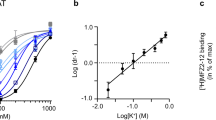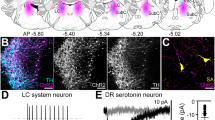Abstract
BEHAVIOURAL1 and neurophysiological2 data suggest the existence of more than one dopamine receptor in the brain3. Differences in drug specificity of the dopamine-sensitive adenylate cyclase and dopamine receptors labelled by the butyrophenones, 3H-haloperidol or 3H-spiroperidol, indicate that the cyclase and the binding sites may, in part, involve distinct receptors4,5. Lesion studies directly demonstrate the existence of physically distinct dopamine receptors in the corpus striatum6. Kainic acid microinjections, which selectively destroy intrinsic neurones in the corpus striatum, almost totally deplete the dopamine-sensitive adenylate cyclase while producing only a 40–50% decline in 3H-haloperidol or 3H-spiroperidol binding. Most of the remaining 3H-haloperidol or 3H-spiroperidol binding is lost following cerebral cortex ablation, which removes a major neuronal input to the corpus striatum, indicating that these binding sites are localised to axons and terminals of the cortico-striate projection6. As the dopamine-sensitive adenylate cyclase is not reduced by cerebral cortex ablation, the cortico-striate dopamine receptors do not seem to be linked to adenylate cyclase. Whether or not the 3H-butyrophenone binding sites destroyed by kainic acid represent the same dopamine receptors as those linked to adenylate cyclase has not been clear. Guanine nucleotides regulate binding at several hormone and neurotransmitter receptors, especially those associated with adenylate cyclase7–13. Previously, we14–16 and others17 showed that dopamine receptor binding of 3H-agonists and 3H-antagonists can be regulated by guanine nucleotides. We now report that kainic acid lesions abolish the sensitivity of dopamine receptor binding to guanine nucleotides. Thus, 3H-spiroperidol and 3H-apomorphine binding sites involve two dopamine receptors, only one of which is regulated by guanine nucleotides.
This is a preview of subscription content, access via your institution
Access options
Subscribe to this journal
Receive 51 print issues and online access
$199.00 per year
only $3.90 per issue
Buy this article
- Purchase on Springer Link
- Instant access to full article PDF
Prices may be subject to local taxes which are calculated during checkout
Similar content being viewed by others
References
Cools, A. R. & van Rossum, J. M. Psychopharmacologia 45, 243–254 (1976).
Siggins, G. R., Hoffer, B. J. & Ungerstedt, U. Life Sci. 15, 779–792 (1976).
Kebabian, J. W. & Calne, D. B. Nature 277, 93–96 (1979).
Creese, I., Burt, D. R. & Snyder, S. H. in Handbook of Psychopharmacology Vol. 10 (eds Iversen, L. L., Iversen, S. D. & Snyder, S. H.) 37–89 (Plenum, New York, 1978).
Kebabian, J. W. Life Sci. 23, 479–484 (1978).
Schwarcz, R., Creeze, I., Coyle, J. T. & Snyder, S. H. Nature 271, 766–768 (1978).
Rodbell, M., Drans, H. M. J., Pohl, S. L. & Birnbaumer, L. J. biol. Chem. 246, 1872–1876 (1971).
Lin, M. C., Nicosia, S., Lad, P. M. & Rodbell, M. J. biol. Chem. 252, 2790–2792 (1977).
Mukherjee, C. & Lefkowitz, R. J. Molec. Pharmac. 13, 291–303 (1977).
Lefkowitz, R. J., Mullikin, D., Wood, C. L., Gove, T. B. & Mukherjee, C. J. biol Chem. 252, 5295–5303 (1977).
Blume, A. J. Proc. natn. Acad. Sci. U.S.A. 75, 1713–1717 (1978).
Childers, S. R. & Snyder, S. H. Life Sci. 23, 759–762 (1978).
U'Prichard, D. C. & Snyder, S. H. J. biol. Chem. 253, 3444–3452 (1978).
Creese, I., Prosser, T. & Snyder, S. H. Life Sci. 23, 495–500 (1978).
Creese, I. & Snyder, S. H. Eur. J. Pharmac. 50, 459–461 (1978).
Creese, I., Usdin, T. & Snyder, S.H. Molec. Pharmac. (in the press).
Zahniser, N. R. & Molinoff, P. Nature 275, 453–455 (1978).
Creese, I. & Synder, S. H. in Catecholamines: Basic and Clinical Frontiers (eds Usdin, E., Kopin, I. J. & Barchas, J. D.) (Pergamon, Oxford, in the press).
Clement-Cormier, Y. C., Parrish, R. G., Petzold, G. L., Kebabian, J. W. & Greengard, P. J. Neurochem. 25, 143–149 (1975).
Author information
Authors and Affiliations
Rights and permissions
About this article
Cite this article
CREESE, I., USDIN, T. & SNYDER, S. Guanine nucleotides distinguish between two dopamine receptors. Nature 278, 577–578 (1979). https://doi.org/10.1038/278577a0
Received:
Accepted:
Published:
Issue Date:
DOI: https://doi.org/10.1038/278577a0
This article is cited by
-
Molecular cloning and characterization of a novel dopamine receptor (D3) as a target for neuroleptics
Nature (1990)
-
The dopamine connection
Nature (1990)
-
Selection of dopamine antagonists discriminating various behavioral responses and radioligand binding sites
Naunyn-Schmiedeberg's Archives of Pharmacology (1984)
-
Dopaminergic binding sites in rat striatal slices and the action of guanyl nucleotides
Naunyn-Schmiedeberg's Archives of Pharmacology (1984)
-
Differential alterations in striatal dopamine receptor sensitivity induced by repeated administration of clinically equivalent doses of haloperidol, sulpiride or clozapine in rats
Psychopharmacology (1984)
Comments
By submitting a comment you agree to abide by our Terms and Community Guidelines. If you find something abusive or that does not comply with our terms or guidelines please flag it as inappropriate.



